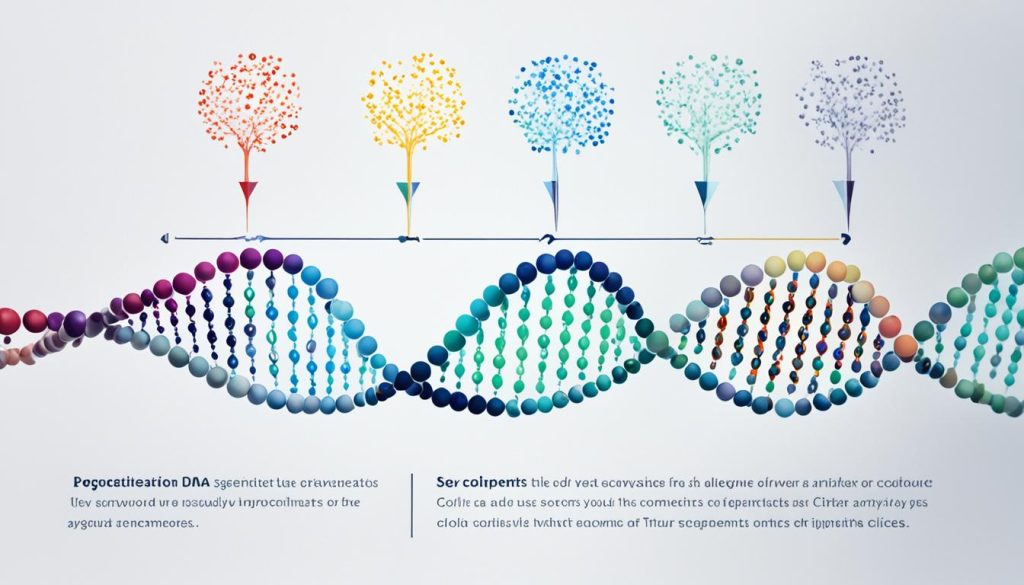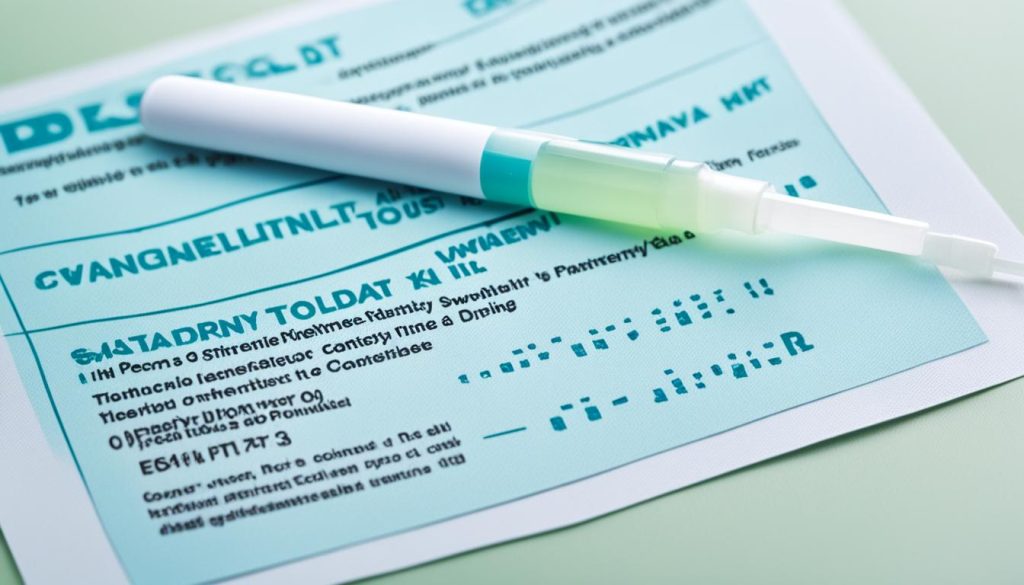Ace Your Exam: Free STR Practice Test Online
Preparing for a forensic science exam requires a deep understanding of DNA analysis and genetic testing. To help you excel in your studies, we offer a free online STR Practice Test that simulates real exam scenarios and provides valuable practice materials.
Our STR Practice Test is designed to sharpen your skills in DNA testing, forensic science, and genetic analysis. By familiarizing yourself with the test format and practicing with sample questions, you can boost your confidence and optimize your performance on the actual exam.
Whether you’re studying for a DNA testing practice exam or seeking comprehensive forensic science exam prep, our STR Practice Test can provide the resources you need for success. With our curated collection of study materials, you can enhance your understanding of key concepts and strengthen your test-taking abilities.

Key Takeaways:
- Our free STR Practice Test offers valuable exam preparation materials for forensic science and DNA analysis.
- Practicing with sample questions can help you familiarize yourself with the test format and boost your confidence.
- Using our study materials will enhance your understanding of DNA analysis and the principles behind genetic testing.
- By honing your test-taking skills, you can optimize your performance on the real exam.
- Prepare for a wide range of questions, including those related to paternity testing, with our comprehensive practice test.
Understanding STR Analysis in Forensic Science
In the field of forensic science, STR analysis plays a crucial role in criminal investigations and genetic testing. To excel in your forensic science exam, it is essential to grasp the fundamentals of STR analysis. This section will provide you with an overview of STR analysis, explaining its significance and its relationship to DNA analysis.
STR Analysis: Significance and Definition
STR analysis, or short tandem repeat analysis, is a technique used to evaluate specific regions of DNA that contain repetitive DNA sequences. These repetitive sequences, known as STR markers, vary from individual to individual, making them valuable in establishing accurate genetic profiles.
By examining STR markers, forensic scientists can compare DNA samples from crime scenes to those of suspects or victims, helping to identify potential perpetrators or confirm biological relationships in paternity testing. STR analysis has revolutionized the field of forensic science, providing a reliable and precise method for genetic identification.
Relationship between STR Analysis and Genetic Testing
Understanding STR analysis is crucial for comprehending the principles behind genetic testing. Genetic testing utilizes STR analysis to analyze an individual’s DNA for various purposes, such as identifying inherited disorders, determining ancestry, and confirming relationships.
By mastering STR analysis, you gain insights into the techniques used in genetic testing, enhancing your overall understanding of DNA analysis principles. This knowledge will prove invaluable as you navigate through forensic science exams.
Now that we have explored the significance of STR analysis and its relationship to genetic testing, let’s delve further into the key concepts of DNA analysis in the next section.
Key Takeaways:
- STR analysis is a technique that evaluates specific regions of DNA containing repetitive sequences called STR markers.
- Forensic scientists use STR analysis to compare crime scene DNA samples with those of suspects or victims.
- STR analysis plays a crucial role in genetic testing, providing insights into inherited disorders, determining ancestry, and confirming relationships.
- By understanding STR analysis, you will gain a solid foundation for acing your forensic science exam.
Key Concepts in DNA Analysis
In this section, we will delve into the key concepts of DNA analysis. Understanding these concepts is crucial for success in your forensic science exam and will be covered in our practice test.
The field of DNA analysis plays a vital role in forensic science, providing valuable insights and evidence in criminal investigations. Let’s explore the fundamental concepts that underpin DNA analysis:
DNA Structure
The structure of DNA, often referred to as the “double helix,” is composed of two strands twisted around each other. These strands are made up of nucleotides, which consist of a sugar molecule, a phosphate group, and a nitrogenous base. The arrangement of these nucleotides forms the genetic code that carries the instructions for creating and functioning organisms.
DNA Replication
DNA replication is a fundamental process in which a cell creates identical copies of its DNA. It occurs during cell division and is crucial for the inheritance of genetic information from one generation to the next. Enzymes unwind the double helix and synthesize new strands by matching complementary nucleotides.
PCR Amplification
PCR (Polymerase Chain Reaction) amplification is a technique used to replicate a specific segment of DNA. This process involves heating the DNA to separate the strands, adding primers that bind to the target DNA region, and using a DNA polymerase enzyme to synthesize new DNA strands. PCR amplification enables the generation of sufficient DNA material for analysis, even from small or degraded samples.
Gel Electrophoresis
Gel electrophoresis is a technique used to separate and analyze DNA fragments based on their size and charge. The DNA samples are loaded onto a porous gel and subjected to an electric current, causing the fragments to migrate through the gel. Larger fragments move more slowly, while smaller fragments move faster. This process allows for the visualization and identification of DNA fragments.
By understanding these key concepts in DNA analysis, you will be well-prepared to tackle questions related to molecular genetics on our practice test. Now, let’s further enhance our knowledge with a visual representation:

| Key Concepts in DNA Analysis | Description |
|---|---|
| DNA Structure | Double helix structure composed of nucleotides carrying genetic information. |
| DNA Replication | The process of creating identical copies of DNA during cell division. |
| PCR Amplification | Technique to replicate a specific segment of DNA for analysis. |
| Gel Electrophoresis | Separation and analysis of DNA fragments based on size and charge. |
Now that we have explored the foundational concepts of DNA analysis, let’s move on to the next section to delve into the importance of STR markers in DNA profiling.
STR Markers: The Building Blocks of DNA Profiling
In the field of forensic science, STR markers play a crucial role in the process of DNA profiling. Understanding the significance of these markers is essential for any aspiring forensic scientist. In this section, we will explore the fundamentals of STR markers, their role in creating DNA profiles, and the importance of STR marker variability.
What are STR Markers?
Short Tandem Repeat (STR) markers are specific regions of human DNA that contain short sequences of nucleotides that repeat in tandem. These repetitive patterns are unique to each individual, making STR markers highly useful for establishing personal identification and determining relationships.
Creating DNA Profiles with STR Markers
When analyzing DNA samples, forensic scientists target several STR markers across the genome. By examining the number of repeats present at each STR marker, a unique DNA profile is created for an individual. This profile serves as a genetic fingerprint and can be used to match DNA samples to potential suspects or establish familial relationships.
Significance of STR Marker Variability
The variability of STR markers is essential for distinguishing individuals and determining degrees of relatedness. The number of repeats in a specific marker can vary significantly between individuals, contributing to the uniqueness and reliability of DNA profiling. STR marker variability allows forensic scientists to distinguish between closely related individuals and identify potential genetic matches.
| Advantages of STR Markers | Limitations of STR Markers |
|---|---|
| Highly polymorphic, increasing the discriminative power of DNA profiling. | Prone to mutation, requiring careful interpretation and analysis. |
| Require small DNA samples, enabling analysis of degraded or limited samples. | Not suitable for all situations, such as highly degraded DNA. |
| Can provide conclusive results in paternity testing and criminal investigations. | Challenging to interpret mixtures of DNA samples. |
Understanding the advantages and limitations of STR markers is crucial for accurate interpretation of DNA profiles in forensic science. By recognizing the complexities associated with STR markers, forensic scientists can make informed decisions during DNA analysis and confidently present their findings in court.
Paternity Testing: Sample Questions and Analysis
In this section, we will explore the fascinating world of paternity testing, which is an important application of STR analysis in forensic science. Paternity testing involves determining the biological relationship between a child and an alleged father by comparing their DNA profiles. To help you gain a better understanding of this process, we have prepared sample questions related to paternity testing. Let’s dive in and analyze the intricacies of these questions to enhance your DNA testing expertise.
Sample Paternity Test Questions:
1. Which genetic marker is commonly used in paternity testing?
- a) Short Tandem Repeat (STR)
- b) Single Nucleotide Polymorphism (SNP)
- c) Variable Number Tandem Repeat (VNTR)
- d) Restriction Fragment Length Polymorphism (RFLP)
2. What is the minimum number of STR loci commonly analyzed in paternity testing?
- a) 5
- b) 10
- c) 15
- d) 20
3. True or False: In paternity testing, if the alleged father does not share any common alleles with the child, he can be excluded as the biological father.
Sample Answer: True. In paternity testing, if the alleged father does not share any common alleles with the child at any of the tested loci, it is highly unlikely that he is the biological father.
4. Why is it important to analyze multiple genetic markers in paternity testing?
- a) To minimize the chances of false positives
- b) To increase the accuracy of determining paternity
- c) To account for genetic variations within populations
- d) All of the above
Now, let’s move on to analyzing the provided sample questions and explore the concepts involved in each one.

Analysis of Sample Questions:
Question 1 focuses on identifying the genetic marker commonly used in paternity testing. Understanding the significance of using Short Tandem Repeats (STRs) is crucial in deciphering DNA profiles for establishing paternity.
Question 2 tests your knowledge of the minimum number of STR loci analyzed in paternity testing. The more STR loci examined, the higher the accuracy of determining paternity.
Question 3 evaluates your understanding of the exclusion principle in paternity testing. Being able to identify the implications of a lack of shared alleles between the alleged father and the child is fundamental in interpreting test results.
Question 4 highlights the importance of analyzing multiple genetic markers when determining paternity. A comprehensive analysis helps minimize false positives, increase accuracy, and account for genetic variations in diverse populations.
By practicing and analyzing these sample questions, you will develop a strong foundation in the principles of paternity testing and gain confidence in DNA analysis techniques.
Now that we’ve explored paternity test sample questions and analyzed the concepts involved, you are well on your way to mastering the intricacies of STR analysis in genetic testing. In the next section, we will focus on enhancing your test-taking skills with valuable tips and strategies to ace your forensic science exam.
Enhance Your Test-Taking Skills: Tips and Strategies
Preparing for your forensic science exam requires more than just knowledge of DNA analysis and genetic testing. Developing effective test-taking skills is crucial for performing well on the STR Practice Test. Here, we provide valuable tips and strategies that will help you navigate the exam confidently.
1. Time Management
One of the key factors in exam success is efficient time management. Plan your study schedule, dedicating specific time slots for different topics. Prioritize areas where you need more practice, such as DNA analysis, and allocate sufficient time for comprehensive review. Practice time-bound mock tests to improve your speed and accuracy.
2. Effective Studying Techniques
Adopting effective studying techniques can optimize your learning and retention. Break down complex concepts into smaller, manageable sections. Utilize mnemonic devices, flashcards, and note-taking to reinforce your understanding. Review and revise regularly to consolidate your knowledge. Additionally, engaging in group study sessions or joining online forums can provide fresh perspectives and clarifications.
3. Approaching Different Types of Questions
Forensic science exams often feature varied question formats, including multiple-choice, true/false, and scenario-based questions. Familiarize yourself with different question formats and learn the strategies to tackle them. For multiple-choice questions, read each option carefully and eliminate obviously incorrect choices. Pay attention to keywords in true/false questions to ensure accurate responses. For scenario-based questions, analyze the given information and apply your knowledge to arrive at the correct answer.
Remember, practice makes perfect. Make use of our online STR Practice Test, which includes a wide range of question formats, to develop familiarity with different question types and improve your confidence.
4. Stay Calm and Focused
Exam anxiety can hinder your performance, so it’s important to stay calm and focused. Practice relaxation techniques, such as deep breathing, before and during the exam. Take breaks when needed but maintain focus without getting distracted. Positive self-talk can also help boost your confidence and reduce stress levels.
5. Analyze Feedback and Learn from Mistakes
After completing the STR Practice Test or any other sample exams, review your performance. Analyze the questions you answered incorrectly and understand the reasons behind your mistakes. This feedback will guide you on areas that need further improvement. Use it as a learning opportunity to enhance your understanding and avoid similar mistakes in the actual exam.
6. Get Sufficient Rest and Maintain a Healthy Lifestyle
Lastly, ensure you prioritize self-care during your exam preparation. Get enough sleep to maintain concentration and cognitive function. Eat a balanced diet to fuel your brain and body. Engage in regular physical activity to reduce stress and enhance overall well-being.
By incorporating these test-taking strategies and implementing them consistently, you will enhance your performance on the STR Practice Test and, ultimately, excel in your forensic science exam.
| Tips and Strategies | Benefits |
|---|---|
| Effective time management | Optimize study schedule and enhance speed |
| Utilize effective studying techniques | Improve learning and retention |
| Approach different types of questions strategically | Maximize accuracy and minimize confusion |
| Stay calm and focused | Reduce anxiety and improve concentration |
| Analyze feedback and learn from mistakes | Identify areas for improvement and enhance understanding |
| Maintain a healthy lifestyle | Promote overall well-being and cognitive function |
Conclusion
In conclusion, mastering DNA analysis is crucial for success in forensic science exams. Our free online STR Practice Test provides the perfect opportunity to sharpen your skills and enhance your exam preparedness. By utilizing our practice test, you can confidently tackle the challenges of DNA testing practice exams and significantly improve your chances of excelling in your forensic science exam.
The STR Practice Test offers a comprehensive platform to assess your knowledge and understanding of STR analysis, DNA analysis, and key concepts in forensic science. It covers essential topics such as STR markers, paternity testing, and the principles behind DNA profiling. With a range of sample questions and analysis scenarios, our practice test equips you with the necessary tools to ace your exam.
By answering practice questions, analyzing STR profiles, and familiarizing yourself with the intricacies of genetic testing, you will build the expertise needed to excel in your forensic science exam. Our STR Practice Test serves as a valuable resource and study aid, providing a realistic exam experience that enhances your test-taking skills and reinforces your understanding of complex forensic science concepts. Prepare with confidence and maximize your chances of success with our free online STR Practice Test.